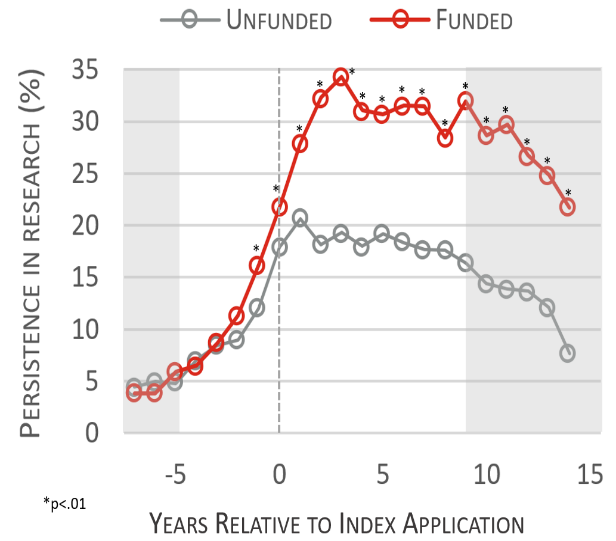7 Comments
Since 1988, the NIH Loan Repayment Programs (LRPs) have been successful in recruiting and retaining early stage investigators into promising biomedical and behavioral research careers. As I have written about before, one of the most significant benefits of these programs is that NIH can repay up to $35,000 in educational loans per year for these talented professionals, which helps alleviate an often cited barrier to entering the biomedical research workforce. Since their inception, NIH LRPs have funded more than 25,000 new and renewal awards totaling more than $950 million (see more data on the LRP Dashboard).
Repaying educational debt is one thing, but what other benefits might these programs provide?
To answer this question, my colleagues within the NIH Office of Extramural Research’s Division of Loan Repayment compared individuals that applied for and received an LRP with those who applied but did not receive an LRP award between fiscal years (FYs) 2003-2009. Their history of productivity was followed through FY 2017. More specifically, we assessed pulled information on grant submissions, awards, and publications in a sample that was equalized to control for baseline differences (n=3,053 applications; funded n=1,095, unfunded n=1,958).
Results indicated that individuals who received an LRP award demonstrated consistently higher levels of what we termed “persistence in research” (Figure 1). This composite measure includes submitting grant or fellowship applications, receiving grant or fellowship awards, and publications. Further, when looking at persistence in research over time, LRP funded individuals demonstrated an approximate two-fold increase in productivity, compared to their unfunded peers. This difference was evident even 14 years after their LRP application.

These findings build on experiences we have heard previously from LRP recipients. In 2014, my colleagues invited 3,005 LRP funded individuals to participate in a customer service study to gauge their experiences in the LRP. Out of the 1,938 who responded, nearly all recipients noted benefiting professionally and personally from participating in the program. Funded applicants cited benefits ranging from being able to pursue research goals, even if it meant having to accept a lower salaried position, reduced clinical duties (i.e., more research time), as well as being more confident that they would succeed in a research career.
Our first look suggests repaying educational debt through NIH LRP awards may be an effective strategy to retain talented early-career behavioral, biomedical, and clinician-scientists in the research workforce. We will continue to assess this pool of LRP awardees and anticipate sharing more data on their research outcomes.
I would like to thank Drs. Ericka Boone and Jill Mattia for their work on this study.



Is the methodology for this study available anywhere?
For example, how was the sample “equalized to control for baseline differences”, and how exactly is the composite persistence metric computed?
Thank you.
When an applicant does not believe their work is supported and they see their neighbors getting these awards, it is easy to just quit the competition. There are many other jobs that pay better for those who are not chosen. Further, for those who do not give up, compensations must be made in order to continue. Take a second job. Do work you do not necessarily have the same passion for in order to pay the bills. Some analyses only verify do not predict.
It’s possible that LRPs were awarded to those with more productive track records.
Thus their higher persistence in research after LRP award is merely indicates that their higher productivity pre LRP award has continued post LRP award.
I applaud rewarding productive individuals but lets not have the NIH mistake causation
It does appear there was a difference in applicants by their measure in years -1 and 0 that implies the funded applicants started ahead. However, the “persistence” diverges dramatically after year 0, which seems to be a point well made.
I forget how to compares to other awards aimed at recruiting physician scientists, but only 1/3 of applicants staying in academics seems low (but better than the apparent alternative)
I was a lucky recipient of NIH_LRP for three cycles. Without that, considering my responsibilities for supporting our family, I would have not been able to stay in academia. Since then I also have helped and mentored others with the LRP applications. Over the years every single early stage physician scientist I have helped and many others that I came to know have obtained the LRP. However, almost all my basic scientist friends and colleagues have tried, failed and given up on their application. I wish NIH would also consider the importance of basic scientist PhDs and their contribution to the field, and increase the number of non-physician applicants who receive the LRP as well.
One explanation for the inequality of productivity may be that those who did not receive the loan repayment had to focus on finances and thus unable to produce scholarship, etc.
Also, is there any data on the ethnic and racial percents? I wonder if that was also a bias.
Thanks for the report.
This analysis suffers terribly from selection bias. I’m a funded RO1 scientist who has sat ad hoc NIH grant committees, but was passed over for LRP.
I’m good enough to be funded and review grants but not good enough to get loans reimbursed? Its downright crazy. I have $50,000 in remaining medical school loans that will force me to leave science.
That’s just a fact.